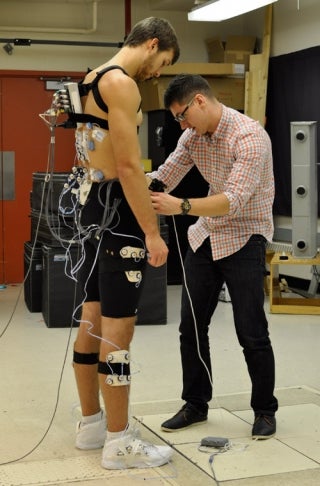
What's the secret behind Jordan Kilganon's epic slam dunks?
Kinesiology researcher examines Kilganon in a Waterloo lab to understand how the world’s best slam dunker gets outstanding air

Kinesiology researcher examines Kilganon in a Waterloo lab to understand how the world’s best slam dunker gets outstanding air
By Christine Bezruki Faculty of Applied Health SciencesHe is being called the best slam dunker in the world and his mid-air acrobatics have taken YouTube by storm. His performance at the NBA All-Star weekend stunned professional players. Now, preliminary research at the University of Waterloo is suggesting Jordan Kilganon’s secret lies in two things – the explosive power in his hips and the rate at which his muscles contract and relax.
“He is a tremendous jumper with outstanding athletic ability,” said Jordan Cannon, the kinesiology graduate student studying Kilganon, a professional dunker from Sudbury, Ontario. “I wanted to understand the strategies he employs and how he generates the power to explode off the floor, and achieve the kind of height that he can.”

To uncover just what makes Kilganon such an athletic outlier, Cannon is using state-of-the-art motion capture and electromyography technology to measure muscle activation and joint angles where he suspects they matter the most—not in the legs, but around the spine and hips.
“Watching videos of Jordan’s jumps, we had a suspicion he was generating the power at his hips to explode off the floor,” said Cannon, who is working under the supervision of world-renowned spine biomechanics expert Professor Stuart McGill. “Most people jump with their knees, and keep their trunk quite upright. But it looked like Jordan was using hips and the core muscles to generate most of the power.”
So far, the data is backing up Cannon’s hypothesis. It’s also providing fascinating new insights into the intricate neural and muscular contributions to Kilganon’s explosive force production.
“While part of Jordan’s explosiveness comes from the way he approaches the jump, generating power with his left hip, a big factor in the equation is the outstanding timing and synchronicity in his muscle activation,” said Cannon.
Kilganon’s finely tuned neural skills allow his muscles to work together more effectively than the average person. He can rapidly contract and relax his muscles before a jump, producing the necessary force and velocity to achieve outstanding height.
“Muscles create force and stiffness, both of which must be controlled for optimal performance,” explained Cannon. “Force is needed to power the jump but muscle relaxation rate governs the ability to maximize the velocity at take-off.”
In the lab, Kilganon wowed researchers by successfully jumping onto a box two inches taller than his own height of 6’1”.
“It’s really best described as a gift,” said Cannon. “His rate of muscle contraction and relaxation is something that sets elite athletes apart from the average ones.”

Jordan Cannon, graduate student in kinesiology, in the lab with Jordan Kilganon
For less-gifted athletes hoping to replicate Kilganon’s skills on the court, Cannon’s study may provide new hope for effective training techniques.
“Our findings may give us a better understanding of how to train athletes,” said Cannon. “Looking at the data and understanding what techniques contribute to Jordan’s jump height and explosiveness will allow other athletes to begin more advanced training programs.”
Kilganon plans to release a three-month jump training program called Bounce Kit for dunkers looking to improve their game. The Kit will use findings from the study to enhance results.
But as Cannon notes, the study has applications beyond basketball.
“This research can be easily be applied to other sports requiring jump performance, whether that is volleyball or soccer,” he said. “In order to train athletes to be the best, you have to understand the best, which is why I’m analyzing Jordan.”

Read more
Researchers awarded funding to investigate ecology, climate change, repatriation, health and well-being through cultural and historical lens

Read more
15 University of Waterloo researchers have been named to the annual Highly Cited Researchers™ list for significant contributions to their specific fields of research

Read more
University of Waterloo researchers find that residents’ poor sleep can trigger problematic medication use, falls and delirium
The University of Waterloo acknowledges that much of our work takes place on the traditional territory of the Neutral, Anishinaabeg, and Haudenosaunee peoples. Our main campus is situated on the Haldimand Tract, the land granted to the Six Nations that includes six miles on each side of the Grand River. Our active work toward reconciliation takes place across our campuses through research, learning, teaching, and community building, and is co-ordinated within the Office of Indigenous Relations.